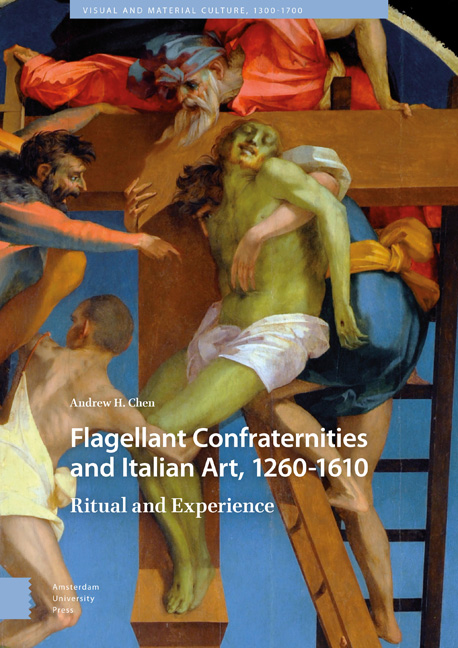Book contents
- Frontmatter
- Deduction
- Contents
- Abbreviations
- List of Illustrations
- Acknowledgements
- Introduction
- Part I Art and Ritual, to 1450
- 1 Flagellation and Its Settings
- 2 Images at Entrances, and Ascesis
- 3 Mass
- 4 Comforting
- 5 Processions
- Part II Transformations
- 6 Changes in Ritual Before Trent
- 7 Changes in imagery before Trent: Sansepolcro and Volterra
- 8 After Trent: Florence and Milan
- Epilogue: Global Flagellation
- Bibliography
- Index of Illuminated Manuscripts (by location)
- Index of Paintings (by location)
- Index of Topics
Epilogue: Global Flagellation
Published online by Cambridge University Press: 11 December 2020
- Frontmatter
- Deduction
- Contents
- Abbreviations
- List of Illustrations
- Acknowledgements
- Introduction
- Part I Art and Ritual, to 1450
- 1 Flagellation and Its Settings
- 2 Images at Entrances, and Ascesis
- 3 Mass
- 4 Comforting
- 5 Processions
- Part II Transformations
- 6 Changes in Ritual Before Trent
- 7 Changes in imagery before Trent: Sansepolcro and Volterra
- 8 After Trent: Florence and Milan
- Epilogue: Global Flagellation
- Bibliography
- Index of Illuminated Manuscripts (by location)
- Index of Paintings (by location)
- Index of Topics
Summary
Flagellation in Spain
The pioneering Trachtenbuch of Christoph Weiditz, the Strasbourg-born medallist who travelled from Augsburg to Spain in 1529 to work at the court of Charles V, contains pictures of two flagellants, one from Castile and one from Zaragoza, among its watercolour drawings of different people from Europe, Africa, and America (Fig. 65). The habit of the Castilian flagellant as drawn by Weiditz resembles the Italian ones that are white, belted at the waist and open at the back. A snubtopped hood covers his head; one cannot say what it looks like from the front. Some Spanish sixteenth-century statute books describe these as capirotes romos– blunt hoods. He strikes himself with a whip. The penitent from Zaragoza, by contrast, wears no shirt, only a skirt tied at the waist. Iconographically he is closer to the flagellants of the 1260 movement who went nudi a cingulo supra (Fig. 3). This man wields a spiky mace. His head, seen in profile, is covered with a cloth tied at the back. Like the hoods of his Italian predecessors, this mask has no eye openings.
Flagellant confraternities were established in the Iberian Peninsula from middle of the fifteenth century. (Earlier in the century, Vincent Ferrer had tried to get them founded there, but this was not so successful.) Many Spanish flagellant confraternities were dedicated to the True Cross. True Cross confraternities were founded in Seville in 1448, Zamora in 1494, Valladolid in 1498, and Salamanca in 1506.
The public rituals of Spanish flagellant confraternities were relatively austere at the outset. The taste for pageantry and splendour was a development of the seventeenth century. Holy Week processions were especially important, as in Italy. The visual effect of these processions in the seventeenth century depended on a stark contrast between the blazing glory of torches and the darkness of night. Foot-washing ceremonies on Thursday evening would be followed by the Office of Tenebrae, a bout of flagellation, and then procession. Spanish confraternities divided their brothers into two categories: Hermanos de la Luz, who carried large tapers, and Hermanos de Sangre, the flagellants. In some confraternities, the Hermanos de la Luz wore white habits, while Hermanos de Sangre wore robes cut of a cruder cloth.
- Type
- Chapter
- Information
- Flagellant Confraternities and Italian Art, 1260–1610Ritual and Experience, pp. 199 - 204Publisher: Amsterdam University PressPrint publication year: 2018



